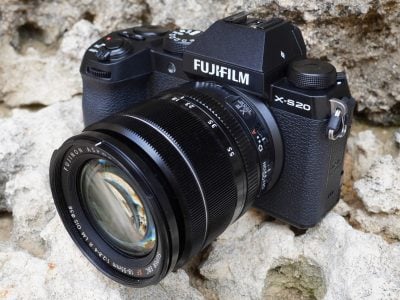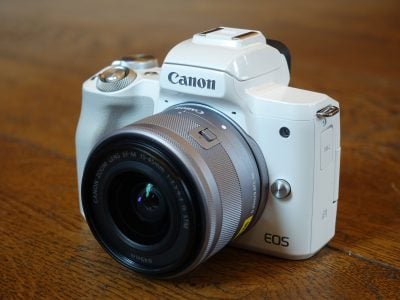Panasonic Lumix DMC-L1
-
-
Written by Gordon Laing
Panasonic Lumix DMC L1 verdict
Panasonic’s Lumix L1 is arguably the most unique digital SLR on sale today. It may share many aspects with the Olympus E330 which provide the Live View, anti-dust system, and allow a flat upper surface, but Panasonic’s gone several steps further by adding a superb lens with optical stabilisation and equipping the L1 with a set of analogue controls which go beyond retro nostalgia to deliver genuine enhancements in usability. The L1 certainly succeeds in making the statement that Panasonic’s arrived in the DSLR market.
Starting with the headline features, Panasonic may only have implemented one of the E330’s Live View modes, but it’s definitely the better of the two. There’s inevitably some compromise in the speed of operation, and Panasonic’s definitely missed a trick by not fitting a flip-out screen, but the Live View function remains very useful none-the-less. While most suited to shooting static subjects with a tripod, it’s also quite usable handheld.
Moving onto anti-dust and the L1 inherits the Olympus SSWF system. As our examples show, the L1 is either highly effective at getting rid of dust, or enjoys an optical path that’s mostly oblivious to it. Either way, we experienced the least dust marks of any recent digital SLR, and are pleased to report the L1 doesn’t waste any time when starting-up.
Next are the analogue controls. While these could first be seen as a novelty, and they do indeed allow the L1 to stand out from the crowd, there are genuine benefits. A mere twist of the aperture ring for example switches the L1 from Program into Aperture Priority with the desired f-number far quicker than selecting a mode, turning a dial then checking the display or viewfinder to confirm your settings.
 |
And finally the lens. Panasonic understands the cachet of having Leica’s first lens designed especially for a DSLR and quotes it in brochures before anything else. The Leica 14-50mm doesn’t disappoint either, delivering excellent quality with minimal aberrations and effective optical stabilisation. It’s a great selling point for the L1 and a tempting upgrade for Olympus DSLR owners when Panasonic starts selling it separately; look out for our in-depth standalone review of the lens soon.
So far the L1 sounds like an ideal DSLR, but it’s not all good news. The viewfinder, like other Four Thirds cameras tested so far, really is much smaller than typical DSLRs, and appears dimmer too despite the optically quick Leica zoom. The L1 may uniquely offer an alternative means of composition with the main screen, but for some photographers the small viewfinder will be a deal-breaker – you’ll have to judge this one for yourself.
The basic three-point AF system, while accurate, is also primitive for off-axis subjects compared to typical 9 and 11-point systems in use by rivals, and the overall handling slower too. The L1’s best-suited to slow moving, or ideally static subjects.
The Live View mode, while useful under the right conditions, is also quite different in practice to that of an all-in-one or compact. The necessary flipping of the mirror delays shooting while also creating quite a racket, and the fixed screen means you won’t be enjoying the tricky angles made possible by a proper flip-out monitor. Many will also lament the absence of a secondary information screen, as the main colour monitor could become hard to read in direct sunlight.
But the biggest issue facing the L1 is its perceived value. It may sport many unique features and come with by far the best kit lens so far, but still has a high cost of entry, especially for a camera with ‘only’ 7.5 Megapixels – it costs typically double that of, say, Canon’s EOS 400D / XTi kit which may have a far worse lens, but boasts higher resolution, lower noise at 1600 ISO, quicker operation and much superior AF. Here’s how it compares with a few key models.
Canon’s EOS 400D / XTi is aimed at a quite different market to the L1 but its sheer popularity still warrants comparison. In its favour, the 400D / XTi is lighter, quicker and sports higher resolution and lower noise at its highest sensitivities. On the downside the anti-dust systems aren’t as effective as the L1, there’s no Live View, the build quality is worse and the Canon kit lens a world apart from the Leica zoom. That said the Canon kit comes in at half the price of the L1 and you could upgrade the lens to a Canon IS model and still have money left. See our Canon EOS 400D / XTi review for more details.
While also aimed at an entry-level market, the Nikon D80 is sufficiently capable to be considered by those shopping for a higher-end camera. Like the Canon 400D / XTi, the D80 boasts higher resolution, lower noise at high sensitivities and quicker handling than the L1, and goes further to offer a superior viewfinder and a secondary status screen. Again though the D80 is lacking anti-dust, Live View and a stabilised kit lens to match the Leica. It is however revealing that for the same money as the L1 kit you could buy a D80 with the DX 18-200mm VR and again still have plenty of change. See our Nikon D80 review.
Compared to Canon EOS 30D
 | |
Canon’s EOS 30D is an arguably fairer comparison for the L1 as it’s aimed at a higher-end market and both cameras share similar build quality. The resolution is roughly the same, although again the 30D boasts lower noise at its highest sensitivities, a better viewfinder and quicker handling, including 5fps shooting. Once again though the 30D is lacking anti-dust, Live View and a decent stabilised kit lens, although for around the same asking price as the L1 kit you could buy the 30D body and the excellent EF-S 17-55mm f2.8 IS, or save money by going for the EF-S 17-85mm. See our Canon EOS 30D review.
If you can afford the Lumix L1, you should definitely be considering the Nikon D200. It has arguably better build quality, higher resolution, lower noise at high ISOs, quicker handling and 5fps shooting, a far superior viewfinder, secondary status screen and external connectivity for GPS and PC Sync lighting. Once again the D200’s lacking the L1’s anti-dust and Live View, and if your budget was exactly the same, you’d be limited to equipping the D200 with a cheaper lens, giving the L1 kit an optical advantage. See our Nikon D200 review.
Final verdict
Ultimately the Lumix L1 is a unique proposition which, while offering worthwhile benefits to anyone, is a camera you’ll either love or hate. The styling alone will be enough to turn you on, or turn you away. It’s certainly designed for a specialist audience and also fair to say most people will be better served by one of the cheaper and more traditional 10 Megapixel DSLRs, especially if they also upgrade to a superior lens – although the difference in real-life detail recorded between them and the L1 is minimal. See our outdoor results page and 10 Megapixel group test for more information.
But if you’re the kind of photographer who’s liked the look of the L1 since it was first announced, you won’t be disappointed. Sure the viewfinder’s relatively small and dim and the operation a little quirky at times, but in its favour the L1’s analogue controls are quick to learn and use, the Live View genuinely useful, the anti-dust system unrivalled, and the Leica zoom the best kit lens around. It may not be best-suited to fast action or very high ISO work, but if you prefer a slower, more considered style of photography, it offers compelling benefits. As manufacturers increasingly converge on style and features, it’s also refreshing to find a camera which can truly be described as unique.
 |
The relatively poor viewfinder and lack of broad appeal means the Lumix L1 can’t receive our highest rating, but we can confidently Recommend it to well-heeled enthusiasts who love the retro look and feel, and want a unique, quality digital SLR. The Lumix L1 is certainly an impressive debut from Panasonic and a valuable addition to the Four Thirds standard. Panasonic’s promised traditional-looking DSLRs for 2007 and we look forward to seeing how it tackles this market. For the L1’s highlights, see our video tour and visit our Semi-pro DSLR Buyer’s Guide for an update of the best buys in this category.
NEW: Check out our Leica D 14-50mm review and video tour, which includes a demonstration of its optical image stabilisation working in practice.
Bad points | Scores (compared to mid-range DSLRs) |
 | ||
Build quality: Image quality: Handling: Specification: Value:
Overall: |
17 / 20 17 / 20 16 / 20 18 / 20 17 / 20
85% | |||







